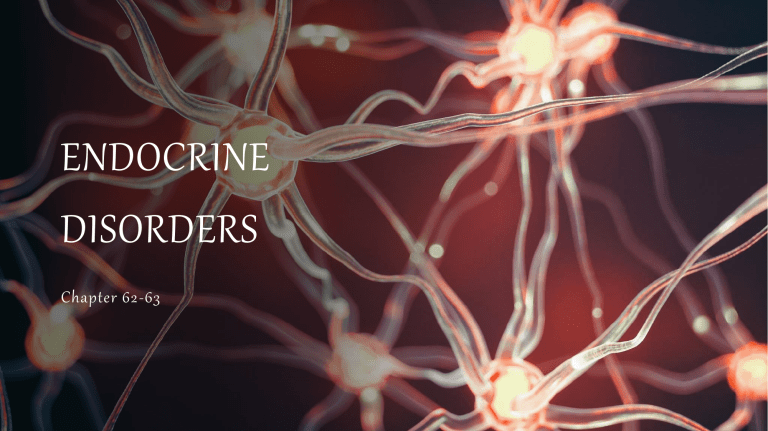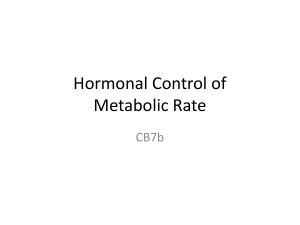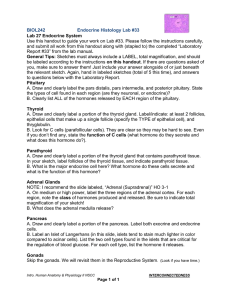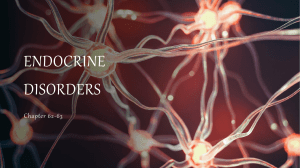
ENDOCRINE DISORDERS Chapter 62-63 Endocrine glands Secrete hormones Thyroxine Cortisol Epinephrine Growth hormone (GH) Parathyroid hormone (PTH) Antidiuretic hormone Basic concepts Hypothalamic-pituitary-hormone axis: Hypothalamus – coordinating center of endocrine system Hypothalamus delivers signal to pituitary gland Pituitary gland releases specific tropic hormone that stimulates endocrine target organ Autoimmunity Genetics Body’s immune system attacks the target organ Creates hormone resistance Type 1 DM Type 2 DM Neoplasm Radiation Tumor growth Common causes of Endocrine dysfunction Endocrine Dysfunction Hypofunction or Hyperfunction Primary Disorder – Due to endocrine gland itself Secondary Disorder – Problem with the pituitary gland Tertiary Disorder – Problem with the hypothalamus Pituitary gland Pea-sized organ “Master gland” Anterior pituitary Follicle-stimulating hormone (FSH) Luteinizing hormone (LH) Growth hormone (GH) Prolactin (PRL) Adrenocorticotropic hormone (ACTH) Thyroid-stimulating hormone (TSH) Posterior pituitary Stores & releases ADH & oxytocin (OCT) (hypothalamus synthesizes) Insufficiency of ADH Posterior Pituitary Polyuria and polydipsia Disorders Partial or total inability to concentrate the urine Diabetes Insipidus Manifestations are related to enhanced water excretion, hypernatremia, and hyper-osmolality Neurogenic (Central DI) Insufficient amounts of ADH Posterior Pituitary Nephrogenic Disorders Inadequate response to ADH by kidney Diabetes Insipidus Psychogenic (Polyuria DI) Partial resistance to ADH, Chronic ingestion of large amounts of water How do you think we might treat DI? Anterior Pituitary Disorders Hypersecretion of growth hormone (GH) Acromegaly – Hypersecretion of GH during adulthood – Gradual growth of jaw, hands, and feet Gigantism – Hypersecretion of GH in children and adolescents – Stimulates growth plates of long bones – 7 ft or taller SIADH Posterior Pituitary Disorders SIADH High levels of ADH (vasopressin) – Ectopic production: small cell lung ca, carcinoma of duodenum & pancreas, leukemia, lymphoma, Hodgkin disease, sarcoma, squamous cell cancer of tongue – Brain injury or infection – Stroke, trauma, bleed, meningitis WHAT DOES ADH DO? ADH released continuously Water retained – fluid overload - - - decreased serum osmolality (dilute) Sodium diluted (hyponatremia) Urine concentrated (increased specific gravity) & excess urine sodium Symptoms Secondary mainly to hyponatremia – T hirst , impaired taste , anorexia, dyspne a with e xe rtion, fatigue, c onfusion, v omiting, abdominal cramping SIADH = Too much Water Retention Thyroid and Parathyroid T hyroi d s ecretes Th yr ox i ne ( T 4 ) Tr i i od ot h yronine ( T 3 ) C al citonin i s a n ta gonist to p a r a t hyroi d h or mon e P a rat hyroid h o rmone ( PTH) P TH r e g u lates se r u m ca l ci u m O p p os e d b y c a l c i t on in f r om t h yr oi d Goiter Large goiters are prevalent in areas of iodine deficiency. Hypothyroidism Deficient production of thyroid hormone by the thyroid gland Most common causes: Hashimoto’s thyroiditis and post Graves’ disease treatment hypothyroidism Hashimoto’s disease is an autoimmune disorder that affects the thyroid Hypothyroidism Symptoms Manifestations: fatigue, cold intolerance, weight gain, constipation, hair loss, Bradycardia, coarse hair, Myxedema, and delayed relaxation of deep tendon reflexes Myxedema – edema around hands, eyes and feet Women may have menstrual irregularities. Labs may show high prolactin levels Treatment involves hormone replacement Hyperthyroidism Excessive thyroid activity Most common causes: Graves’ disease Thyroiditis Toxic Multi-Nodal Goiter Toxic Adenomas Graves Disease Most common cause of thyrotoxicosis Autoimmune Disorder in which antibodies directed against TSH receptors result in continuous stimulation of thyroid gland to produce and secrete thyroid hormones. Symptoms: goiter, exophthalmos , pre-tibial myxedema, palpitations, insomnia, weight loss, heat intolerance, menses with lighter flow or shorter duration and brittle hair. Thyroid Storm An acute exacerbation of hyperthyroidism. It can be caused by inadequate treatment of hyperthyroidism and stressful conditions such as surgery, infection, and DKA. Excess thyroid hormone increases systemic adrenergic activity, which results in epinephrine over production and severe hyper-metabolism. Thyroid storm: symptoms Life threatening: heart failure & pulmonary edema can develop High fever Tachycardia N&V Tremulousness Agitation Psychosis Can cause coma with hypotension later MANIFESTATIONS OF THYROID ALTERATIONS Parathyroid glands Pea-sized glands in thyroid tissue Produce & secrete PTH What does PTH do? Hyper Results in fracture’s, potential for kidney stones Hypercalcemia Hypo and Hyper Hypo parathyroidism Results in muscle spasms (tetany), hyperreflexia, dry skin Hypocalcemia Adrenal Glands C o rte x s e c re t e s M e d ul la s e c r e te s G l u co c ort ic o ids ( c ort ic o st e roids) – C o rti so l – C o r ti s o ne – C o r ti c o ste r o n e M i ne ral cort ic oids – A ldost erone Adrenal estrogen a n d a n d r o g e ns C a te c h olamine s – E p inephri ne – N o repi nephrine Lack of glucocorticoids produced by adrenal cortex Glucocorticoids are essential in glucose metabolism Addison’s Disease: Causes Lack of mineralocorticoids produced by adrenal cortex Mineralocorticoids are essential in sodium and potassium balance Deficiency in the adrenal cortex to produce glucocorticoid and/or mineralocorticoid Adrenal Disorders – Addison’s Disease (hypocortisolism) – Primary Hypocortisolism – Addison’s Disease – Secondary Hypocortisolism – Low or absent ACTH levels Cushing’s Syndrome Hyperfunction of adrenal glands Cushing’s syndrome: Excess glucocorticoids “Classic” syndrome: Weight gain, truncal obesity, moon face, buffalo hump, purple striae, HTN, muscle weakness Cushing Syndrome





